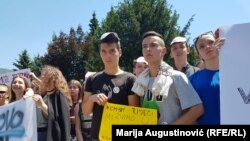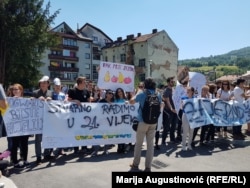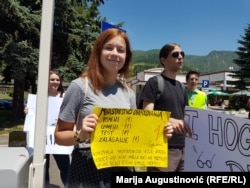One down, 57 to go.
That's the scorecard students in the town of Jajce in Bosnia-Herzegovina held after their protests pushed the government to drop plans to force them into an ethnically divided school after a year-long campaign.
Flush with that success, the students have vowed to continue their struggle against segregation in 57 other schools, claiming the system fosters ethnic tensions from an early age.
"We want quality education, not division," said Faruk Gutic, a member of the Association of High School Students of Bosnia and Herzegovina. "We want to work. Don't let us fall back to 20 years in the past."
Separating students within the same building along ethnic lines to learn curriculums in Bosnian, Serbian, or Croatian came about following the Balkan war of the 1990s, which was sparked by a wave of nationalism that swept through the country during the breakup of the former Yugoslavia.
It's now more than 20 years after the brutal war that pitted Bosnian Serbs, Croats, and Bosnian Muslims, or Bosniaks, against each other, but reconciliation has been slow.
Pock-marked walls, riddled with bullets from the 1992-95 conflict that left almost 100,000 dead and displaced more than 2 million people, are a constant reminder of how deep the schism between Bosnia's three main ethnic groups is.
Interethnic tensions still run high in the country and the political discourse, including in the media, includes the frequent use of hate speech. Short-term solutions that were put in place to calm tensions after the war remain, as do many Bosniak, Croat, and Serb nationalist parties that derive their power from mutual distrust.
One of those solutions was the so-called "two schools under one roof" policy.
Many displaced Bosnians didn't want to reintegrate into communities where they might be neighbors with those who opposed them during the war. As a compromise to complete segregation, some schools were set up with two different systems under the same roof.
The practice allows separate school boards to develop specific curriculums taught by teachers from their own ethnic group. While the buildings are shared, some have students go to school in different shifts, while in others children actually enter the building via separate entrances.
Croat and Bosniak kids even use different toilets.
"I think the children and their parents are hostage to an unscrupulous political game, and we will only see the consequences of this in 10 or 15 years," a former Jajce student and activist, Samir Beharic, said last year.
The system remains even though the Federation Constitutional Court ruled in 2014 that it is discriminatory and the United States and international agencies such as the Organization for Security and Cooperation in Europe have voiced their opposition to the practice.
"Ending all forms of ethnic segregation in schools is probably one of the most important tasks for Bosnia and Herzegovina," European Commission against Racism and Intolerance Chairman Christian Ahlund said in a recent report on the practice.
"It is absolutely vital in order to build an inclusive society and to spare future generations the curse of ethnic divisionism and hatred," he added.
Ambassador Jonathan Moore, the head of the OSCE's mission to Bosnia, congratulated the students in a tweet following their victory.
"Congratulations to the secondary school graduates in #Jajce and thanks for seeking #QualityEducation," he wrote.
Student protests have echoed the sentiments of Western institutions opposed to the practice.
In a recent demonstration, some held signs reading: "Segregation is a bad investment." Others read: "We are here to create the future, not to repeat the past."
Education Minister Katica Cerkez acknowledged the problem when she met with students recently, but cautioned that change would take time and patience.
"The initiative by the students is understandable, but they are highlighting a problem facing the entire Bosnia-Herzegovina and it can't be solved in a few quick steps," she said.
"This is a deep problem in our society and it is defined by the constitution and our laws," Cerkez added.
Dennis Gratz, a federal lawmaker from Sarajevo, went a step further and on June 20 proposed a law to ban segregation in schools.
"This is a rule that will unequivocally determine that every form of physical division of persons, especially students and professors during classes, extracurricular activities, and breaks, is segregation and discrimination, and that the federation has the competencies and the duty to ban such a practice -- not from the perspective of education, but out of a duty to protect human rights and civic freedoms," Gratz said.
That does little to quell the dissent from inside the student body.
Student leaders, spurred by their first taste of success, said they are going to press on in other parts of the country to stop the practice.
"We don't hate each other and the fact that politicians are trying to instill this hatred in us is wrong," said Adnan Brajamovic, a student from Sarajevo.











